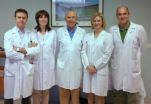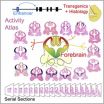(Press-News.org) The scientists, from Imperial College London, say their research brings them another step closer to a new kind of industrial revolution, where parts for these biological factories could be mass-produced. These factories have a wealth of applications including better drug delivery treatments for patients, enhancements in the way that minerals are mined from deep underground and advances in the production of biofuels.
Professor Paul Freemont, Co- Director of the Centre for Synthetic Biology and Innovation at Imperial College London and principle co-investigator of the study, which is published today in the journal Nucleic Acids Research, says:
"Before the industrial revolution most items were made by hand, which meant that they were slower to manufacture, more expensive to produce and limited in number. We are at a similar juncture in synthetic biology, having to test and build each part from scratch, which is a long and slow process. We demonstrate in our study a new method that could help to rapidly scale up the production and testing of biological parts."
Parts made up of DNA are re-engineered by scientists and put into cells to make biological factories. However, a major bottleneck in synthetic biology is the lack of parts from which to build new types of factories. To build parts using the current time-consuming method, scientists have to re-engineer DNA in a cell and observe how it works. If it functions according to their specifications, then the scientists store the part specifications in a catalogue.
Now, scientists from Imperial College London have devised a much quicker method that does away with the need for them to re-engineer a cell every time they want to make a new part. The team say their work could lead to vast new libraries of off-the-shelf components that could be used to build more sophisticated biological factories.
James Chappell, co-author of the study from the Centre for Synthetic Biology and Innovation at Imperial College London, says:
"One of the major goals in synthetic biology is to find a way to industrialise our processes so that we can mass produce these biological factories much in the same way that industries such as car manufacturers mass produce vehicles in a factory line. This could unlock the potential of this field of science and enable us to develop much more sophisticated devices that could be used to improve many facets of society. Excitingly, our research takes us one step closer to this reality, providing a rapid way of developing new parts."
When a cell is re-engineered, the re-programmed DNA in the cell encodes a message that is conveyed by molecules called messenger ribonucleic acid (mRNA) to the cell's production factories called ribosomes. The ribosomes translate the genetic information into a command that instructs the cell to perform functions. For example, scientists can already re-engineer a cell into an infection detector factory, which produces a protein that detects chemical signals from human pathogenic bacteria and changes colour to indicate their presence.
In the study, the Imperial researchers demonstrate for the first time that the same method can be achieved in a test tube outside of a cell. This involves extracting from cells the machinery that produces mRNA and proteins and providing the energy and building blocks to help them survive in test tubes. The team then add their re-programmed DNA to the solution and observe how it functions.
The advantage of this method is that scientists can develop litres of this cell-like environment so that multiple re-programmed DNA can be tested simultaneously, which speeds up the production process of parts.
The next stage of the research is to expand the types of parts and devices that can be developed using this method. They also are aiming to develop a method using robots to speed up and make the whole process automated.
Professor Richard Kitney, co- Director of the Centre for Synthetic Biology and Innovation at Imperial College London says: "Synthetic biology is seen by the British Government as having the potential to create new industries and jobs for the benefit of the UK economy. This work is part of a wider, major research programme within the Centre to develop technology that can be used across a range of industrial applications."
###
For further information please contact:
Colin Smith
Senior Research Media Officer
Imperial College London
Out of hours duty press officer: 44-0-7803-886-248
Notes to editors:
1. "Validation of an entirely in vitro approach for rapid prototyping of DNA regulatory elements for synthetic biology" Nucleic Acids Research journal, published online Thursday 31 January 2013
James Chappell [1], Kirsten Jensen [1] and Paul S. Freemont [1]
[1] Centre for Synthetic Biology and Innovation, Division of Molecular Bioscience, Imperial College London, South Kensington Campus, London, SW7 2AZ, UK
A copy of the paper at manuscript stage: https://fileexchange.imperial.ac.uk/files/5ee2d5bf026/NAR%20MS.pdf
2. About Imperial College London
Consistently rated amongst the world's best universities, Imperial College London is a science-based institution with a reputation for excellence in teaching and research that attracts 14,000 students and 6,000 staff of the highest international quality. Innovative research at the College explores the interface between science, medicine, engineering and business, delivering practical solutions that improve quality of life and the environment - underpinned by a dynamic enterprise culture.
Since its foundation in 1907, Imperial's contributions to society have included the discovery of penicillin, the development of holography and the foundations of fibre optics. This commitment to the application of research for the benefit of all continues today, with current focuses including interdisciplinary collaborations to improve global health, tackle climate change, develop sustainable sources of energy and address security challenges.
In 2007, Imperial College London and Imperial College Healthcare NHS Trust formed the UK's first Academic Health Science Centre. This unique partnership aims to improve the quality of life of patients and populations by taking new discoveries and translating them into new therapies as quickly as possible.
Website: www.imperial.ac.uk
Discovery in synthetic biology takes us a step closer to new 'industrial revolution'
Scientists report that they have developed a method that cuts down the time it takes to make new 'parts' for microscopic biological factories from 2 days to only 6 hours
2013-02-01
ELSE PRESS RELEASES FROM THIS DATE:
The genome of rock pigeon reveals the origin of pigeons and the molecular traits
2013-02-01
January 31, 2013, Shenzhen, China – In a study published today in Science, researchers from University of Utah, BGI, and other institutes have completed the genome sequencing of rock pigeon, Columba livia, among the most common and varied bird species on Earth. The work reveals the evolutionary secrets of pigeons and opens a new way for researchers to study the genetic traits controlling pigeons' splendid diversity. The findings also help to fill the genetic gaps in exploiting pigeon as a model for the molecular genetic basis of avian variation.
People are quite familiar ...
Placental blood flow can influence malaria during pregnancy
2013-02-01
Malaria in pregnancy causes a range of adverse effects, including abortions, stillbirths, premature delivery and low infant birth weight. Many of these effects are thought to derive from a placental inflammatory response resulting from interaction of infected red blood cells with the placental tissue. In a study published in the latest issue of the journal PLOS Pathogen*, a researchers' team led by Carlos Penha-Gonçalves at the Instituto Gulbenkian de Ciência (IGC), Portugal, observed, for the first time, the mouse placental circulation and showed how it can influence the ...
Sequencing hundreds of chloroplast genomes now possible
2013-02-01
Researchers at the University of Florida and Oberlin College have developed a sequencing method that will allow potentially hundreds of plant chloroplast genomes to be sequenced at once, facilitating studies of molecular biology and evolution in plants.
The chloroplast is the compartment within the plant cell that is responsible for photosynthesis and hence provides all of the sugar that a plant needs to grow and survive. The chloroplast is unusual in containing its own DNA genome, separate from the larger and dominant genome that is located in every cell's nucleus. ...
Examining the so-called Basque mutation of Parkinson's
2013-02-01
This press release is available in Spanish.
The relationship between genetics and Parkinson's has been investigated for more than a decade, but it is only over the last few years that significant results have begun to be obtained. The first mutations related to the development of this disease were found in 2004. A team from the UPV/EHU-University of the Basque Country came across a mutation of the LRRK2 gene, which is particularly prevalent among the population of Gipuzkoa. It is the R1441G mutation and is known as the Basque mutation. Now, Doctor Javier Ruiz, a doctor ...
NASA sees a coronal mass ejection erupt from the sun
2013-02-01
On Jan. 31, 2013 at 2:09am EST, the sun erupted with an Earth-directed coronal mass ejection or CME. Experimental NASA research models, based on observations from the Solar Terrestrial Relations Observatory (STEREO) and ESA/NASA's Solar and Heliospheric Observatory, show that the CME left the sun at speeds of around 575 miles per second, which is a fairly typical speed for CMEs. Historically, CMEs at this speed are mild.
Not to be confused with a solar flare, a CME is a solar phenomenon that can send solar particles into space and reach Earth one to three days later.
Earth-directed ...
The effective collective: Grouping could ensure animals find their way in a changing environment
2013-02-01
For social animals such as schooling fish, the loss of their numbers to human activity could eventually threaten entire populations, according to a finding that such animals rely heavily on grouping to effectively navigate their environment.
Princeton University researchers report in the journal Science that collective intelligence is vital to certain animals' ability to evaluate and respond to their environment. Conducted on fish, the research demonstrated that small groups and individuals become disoriented in complex, changing environments. However, as group size is ...
Evidence of geological 'facelift' in the Appalachians
2013-02-01
How does a mountain range maintain its youthful, rugged appearance after 200 million years without tectonic activity? Try a geological facelift – courtesy of the earth's mantle.
Researchers from North Carolina State University noticed that a portion of the Appalachian Mountains in western North Carolina near the Cullasaja River basin was topographically quite different from its surroundings. They found two distinct landscapes in the basin: an upper portion with gentle, rounded hills, where the average distance from valley to mountain top was about 500 feet; and a lower ...
Genome-wide atlas of gene enhancers in the brain online
2013-02-01
Future research into the underlying causes of neurological disorders such as autism, epilepsy and schizophrenia, should greatly benefit from a first-of-its-kind atlas of gene-enhancers in the cerebrum (telencephalon). This new atlas, developed by a team led by researchers with the U.S. Department of Energy (DOE)'s Lawrence Berkeley National Laboratory (Berkeley Lab) is a publicly accessible Web-based collection of data that identifies and locates thousands of gene-regulating elements in a region of the brain that is of critical importance for cognition, motor functions ...
New role for DNA methylation in subset of premature aging disorder patients
2013-02-01
Scientists at the Bellvitge Biomedical Research Institute in Barcelona, Spain have found new evidence for the role of epigenetic changes (those heritable alterations in gene expression caused by mechanisms other than changes in DNA sequence) on premature aging diseases. A new study published in the journal Epigenetics on Jan. 1, 2013, identified a role for DNA methylation changes in a subset of Hutchinson-Gilford Progeria and Werner Syndrome patients, for which no genetic cause (such as DNA mutation) had been associated with onset disease. The study, titled "Aberrant DNA ...
Safe sex practices among African American women
2013-02-01
Los Angeles, CA (January 31, 2013) Researchers have found that African American women exhibit a higher risk for sexually transmitted infections including HIV/Aids. But what motivates this group of women to have sex? And when are they more likely to use protection?
A new study published today in Health Education & Behavior (a SAGE journal) found that regardless of motivations for having sex, condom use expectations were less than 50% for all types of sexual encounters, including the riskiest types of sex.
Researchers Julianna Deardorff et. al used a combination of interviews ...
LAST 30 PRESS RELEASES:
Air pollution exposure and birth weight
Obstructive sleep apnea risk and mental health conditions among older adults
How talking slows eye movements behind the wheel
The Ceramic Society of Japan’s Oxoate Ceramics Research Association launches new international book project
Heart-brain connection: international study reveals the role of the vagus nerve in keeping the heart young
Researchers identify Rb1 as a predictive biomarker for a new therapeutic strategy in some breast cancers
Survey reveals ethical gaps slowing AI adoption in pediatric surgery
Stimulant ADHD medications work differently than thought
AI overestimates how smart people are, according to HSE economists
HSE researchers create genome-wide map of quadruplexes
Scientists boost cell "powerhouses" to burn more calories
Automatic label checking: The missing step in making reliable medical AI
Low daily alcohol intake linked to 50% heightened mouth cancer risk in India
American Meteorological Society announces Rick Spinrad as 2026 President-Elect
Biomass-based carbon capture spotlighted in newly released global climate webinar recording
Illuminating invisible nano pollutants: advanced bioimaging tracks the full journey of emerging nanoscale contaminants in living systems
How does age affect recovery from spinal cord injury?
Novel AI tool offers prognosis for patients with head and neck cancer
Fathers’ microplastic exposure tied to their children’s metabolic problems
Research validates laboratory model for studying high-grade serous ovarian cancer
SIR 2026 delivers transformative breakthroughs in minimally invasive medicine to improve patient care
Stem Cell Reports most downloaded papers of 2025 highlight the breadth and impact of stem cell research
Oxford-led study estimates NHS spends around 3% of its primary and secondary care budget on the health impacts of heat and cold in England
A researcher’s long quest leads to a smart composite breakthrough
Urban wild bees act as “microbial sensors” of city health.
New study finds where you live affects recovery after a hip fracture
Forecasting the impact of fully automated vehicle adoption on US road traffic injuries
Alcohol-related hospitalizations from 2016 to 2022
Semaglutide and hospitalizations in patients with obesity and established cardiovascular disease
Researchers ‘listen in’ to embryo-mother interactions during implantation using a culture system replicating the womb lining
[Press-News.org] Discovery in synthetic biology takes us a step closer to new 'industrial revolution'Scientists report that they have developed a method that cuts down the time it takes to make new 'parts' for microscopic biological factories from 2 days to only 6 hours




